Key Takeaways
-
Hoshin Kanri X matrix is a visual tool used in Lean management to align long-term goals with daily activities.
-
Why use it? To ensure that everyone is pulling in the same direction, from leadership to front-line teams.
-
What does it include? Goals, objectives, metrics, priorities, ownership, and interdependencies - all in one place.
-
What are the benefits? Clear alignment, improved accountability, measurable progress, and ongoing continuous improvement.
What Is the Hoshin Kanri X Matrix?
The Hoshin Kanri X matrix, also known simply as the X matrix, is a Lean strategic planning tool that visualizes how long-term goals connect to annual objectives, key improvement priorities, and measurable metrics.
Shaped like an "X", it places:
-
Long-term goals at the bottom (South)
-
Annual objectives on the left (West)
-
Improvement priorities at the top (North)
-
Key metrics on the right (East)
At the far right, you'll find the names of owners accountable for delivery. At each corner, the matrix uses visual markers to show how these elements are interdependent.
This structure encourages strategic clarity, ownership, and a line of sight from high-level ambitions to operational action.
 Example of a Hoshin Kanri X matrix
Example of a Hoshin Kanri X matrix
How Does the Hoshin Kanri X Matrix Support Alignment and Communication?
The matrix bridges vision and execution by translating broad goals into specific, trackable outcomes. It serves as a single source of truth for:
- Strategy owners to communicate direction
- Managers to assign responsibility
- Teams to understand their contribution
- Everyone to track progress
Combined with Hoshin Kanri Catchball, it builds a feedback loop that ensures the matrix reflects both top-down vision and bottom-up insight.
How to Build and Implement a Hoshin Kanri X Matrix: Step-by-Step
Step 1: Set the Strategic Vision & Long-Term Goals
Start by listing your key goals for the next 3–5 years in the bottom (South) quadrant. Don't overcrowd this section - each goal should be broken down into actionable plans before adding the next.
Step 2: Define Key Mid-Term Objectives
Next, map the annual objectives in the left (West) quadrant. These are the key objectives your team needs to accomplish this year to stay on track with the strategic vision.
Step 3: Set Improvement Priorities and Key Metrics
Place your major short-term actions in the top (North) quadrant. These are the activities your team must complete to achieve annual goals.
On the right (East), define the KPIs that will measure success. Be selective and align metrics with each objective. At this stage, you're building the basis for tracking real progress.
Step 4: Agree on KPIs and Assign Ownership
Now apply Catchball: share the draft matrix with stakeholders, gather feedback, and validate the metrics. Next to your KPIs, list owners, team leads, or process owners accountable for execution.
While Lean encourages shared responsibility, assigning a lead ensures clarity and prevents dropped initiatives.
Step 5: Connect the Dots with Dependency Mapping
The final step is to visually mark the relationships between quadrants. Use simple symbols (e.g., circles, triangles) to indicate primary and secondary connections. Keep it intuitive and avoid over-complication.
This step ensures that everyone can see how the elements influence one another at a glance.
How to Use the Hoshin Kanri X Matrix for Strategic Planning: A Real-World Example
Let's say a bank is using the Hoshin Kanri X matrix to boost digital transformation and customer satisfaction.
Long-Term Objectives (South)
- Expand digital banking services for Gen Z
- Increase customer satisfaction by 30% in 5 years
- Grow investment management services
- Become top mortgage lender in the region
 Example of long-term objectives on a Hoshin Kanri X matrix
Example of long-term objectives on a Hoshin Kanri X matrix
Annual Objectives (West)
- Launch a mobile banking app
- Improve customer service by 6%
- Increase assets under management by 15%
- Boost home loan approvals by 20%
 Example of annual objectives on a Hoshin Kanri X matrix
Example of annual objectives on a Hoshin Kanri X matrix
Top Level Improvement Priority (North)
- Develop app with mobile check deposits
- Train all staff in service excellence
- Roll out investment service campaigns
- Launch competitive mortgage offers
 Mapping top priorities on a Hoshin Kanri X matrix
Mapping top priorities on a Hoshin Kanri X matrix
Metrics (East)
- Monthly active users of the app
- Quarterly customer satisfaction surveys
- Annual growth in investment assets
- Monthly mortgage approval rates
 Visualizing key metrics on a Hoshin Kanri X matrix
Visualizing key metrics on a Hoshin Kanri X matrix
Here, each initiative is tied to measurable outcomes and assigned stakeholders. For example, the mobile app initiative contributes directly to expanding digital offerings while improving customer satisfaction.
What Are the Best Practices for Linking Strategy to KPIs?
- Align each KPI with a specific goal or objective.
- Validate metrics through Catchball to ensure they're meaningful.
- Use real-time tracking tools to monitor performance.
- Limit the number of metrics to avoid complexity.
- Regularly revisit and adjust KPIs as needed.
What Are Common Challenges When Using the Hoshin Kanri X Matrix?
-
Too many goals: Dilutes focus - prioritize what truly matters.
-
Lack of ownership: Leads to confusion - assign accountable leads.
-
Disconnected metrics: Makes tracking ineffective - tie KPIs directly to strategy.
-
Poor communication: Undermines trust - foster open feedback through Catchball.
How Does the Hoshin Kanri X Matrix Support Continuous Improvement?
Because it's iterative, the Hoshin Kanri X matrix promotes reflection and refinement. Use it to:
Over time, it becomes a living document that evolves alongside your team and strategy.
Tools or Templates to Build a Hoshin Kanri X Matrix
While paper or spreadsheets work, digital tools can simplify implementation by:
- Providing interactive X matrix templates
- Linking matrix goals to team boards and workflows
- Tracking progress automatically across strategic levels
- Supporting Catchball through comments, notifications, and task ownership
From Strategy to Execution: Bringing the Hoshin Kanri X Matrix to Life with Businessmap
Once your Hoshin Kanri X matrix is complete, the real work begins - translating strategy into everyday execution. While the matrix helps visualize alignment, you'll need a system to break down top-level goals into actionable work.
»» Let's say your leadership team defines two 4-year strategic initiatives.
In Businessmap, you create these initiatives directly on a Management Workspace. From there, you break each one into focused strategies and mid-term objectives - visible as separate rows or lanes linked to each initiative.
 Using a Hoshin Kanri board to visualize breakthrough objectives in a top workflow in Businessmap
Using a Hoshin Kanri board to visualize breakthrough objectives in a top workflow in Businessmap
»» Then, you drill down again.
Each strategy is supported by 2–3 high-impact projects created at the team level, connected upstream to strategic goals. These projects are further broken down into individual tasks that team members start processing.
 Visualizing annual goals in a second-layer workflow in Businessmap
Visualizing annual goals in a second-layer workflow in Businessmap
»» As tasks move across the board, their progress feeds directly into your top-level initiatives, providing real-time visibility at every layer - from operations to the C-suite. You can even link boards together to form a hierarchy that reflects your actual organizational structure.
What makes this approach powerful is full transparency and alignment: teams know how their daily work contributes to the company's strategy, and leaders can monitor performance without micromanaging.
 Visualizing top-priority projects on a Hoshin Kanri board in Businessmap
Visualizing top-priority projects on a Hoshin Kanri board in Businessmap
Turn Strategy into Action with the Hoshin Kanri X Matrix
The Hoshin Kanri X matrix is more than a visualization - it's a Lean communication tool that brings clarity, alignment, and continuous improvement into your strategic planning.
Start by mapping your vision. Invite feedback. Assign ownership. And connect every goal to a metric and an action.
Done right, the matrix doesn't just track progress - it creates it.
Businessmap is the most flexible software
to align work with company goals
In Summary
The Hoshin Kanri X Matrix is an excellent tool of the Hoshin Kanri method that allows you to:
- Visualize your long-term strategy and break it down to align goals with actions.
- Put a clear emphasis on the most important initiatives that you need to complete.
- Make the dependencies in your process transparent.
- Bridge Hoshin Kanri to other Lean methods, such as Kanban, to maximize the effect.





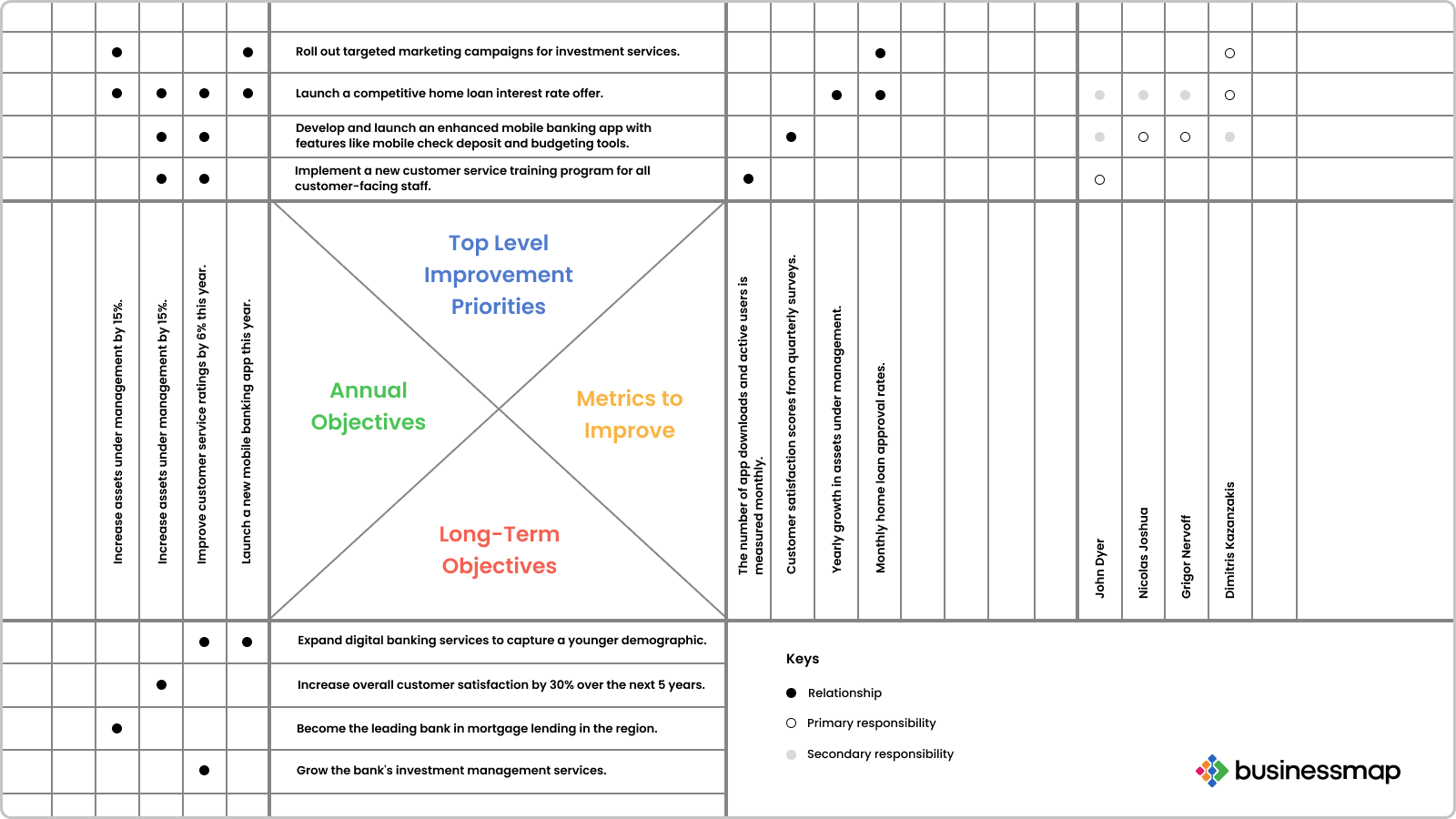 Example of a Hoshin Kanri X matrix
Example of a Hoshin Kanri X matrix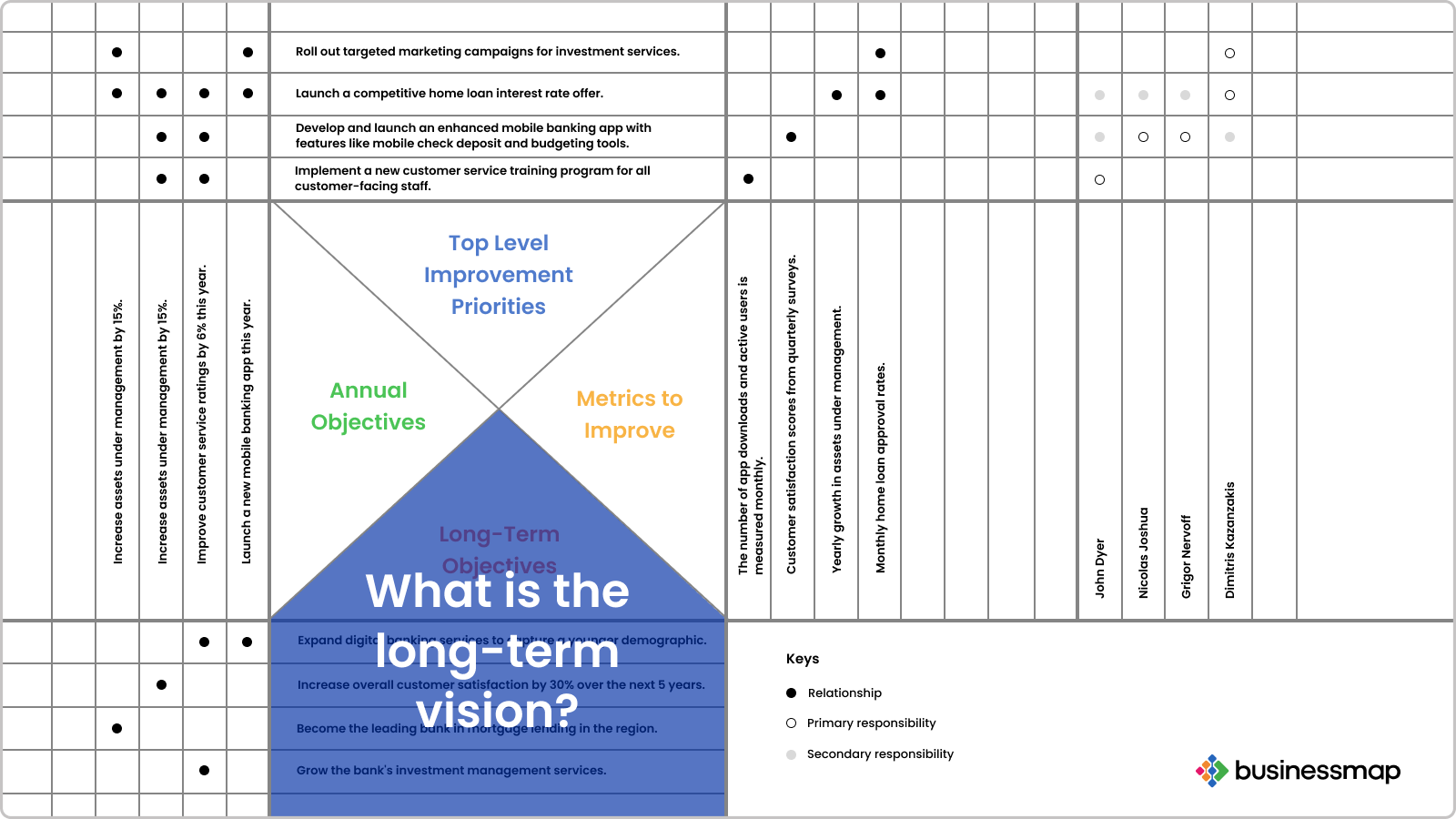 Example of long-term objectives on a Hoshin Kanri X matrix
Example of long-term objectives on a Hoshin Kanri X matrix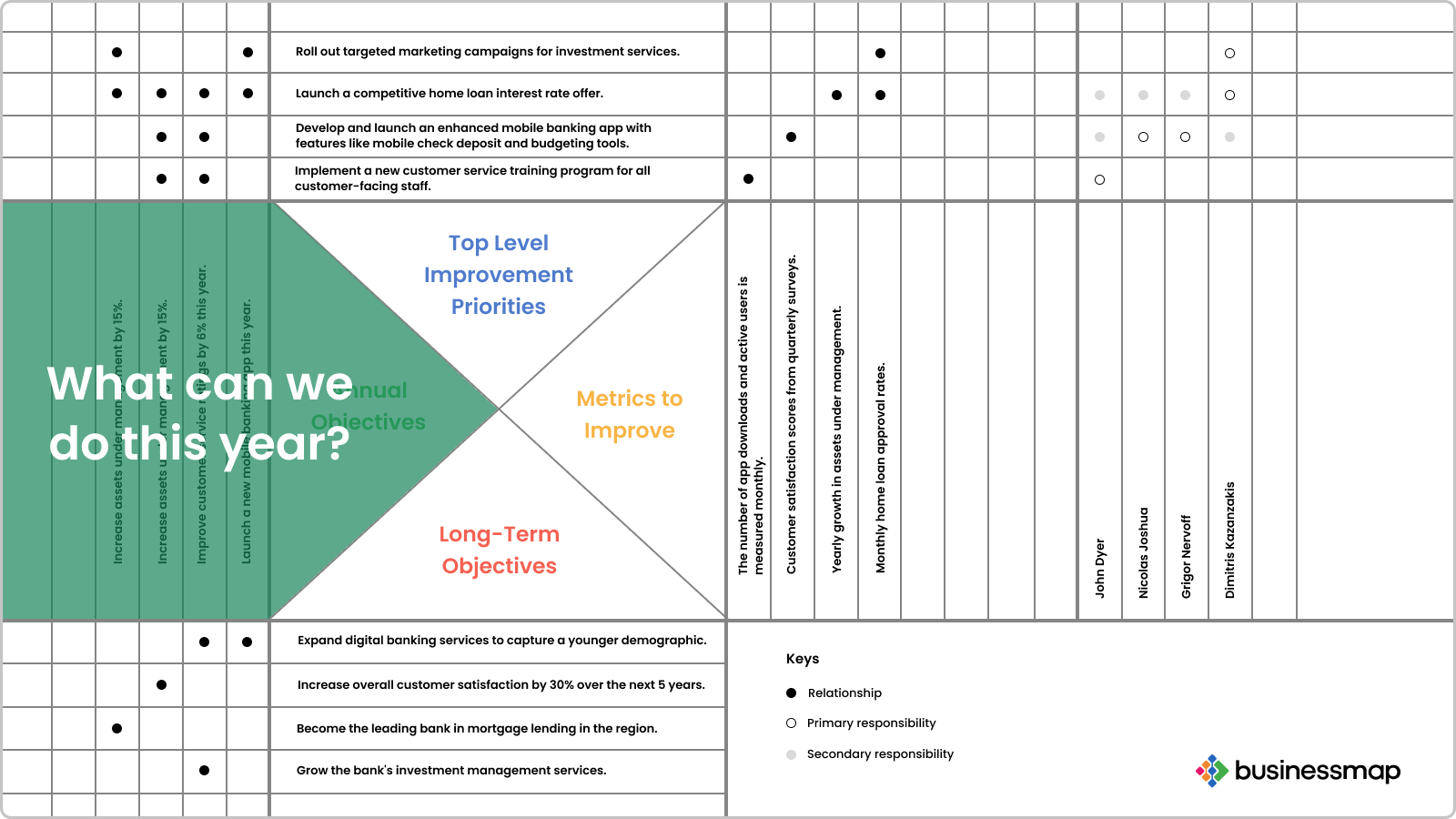 Example of annual objectives on a Hoshin Kanri X matrix
Example of annual objectives on a Hoshin Kanri X matrix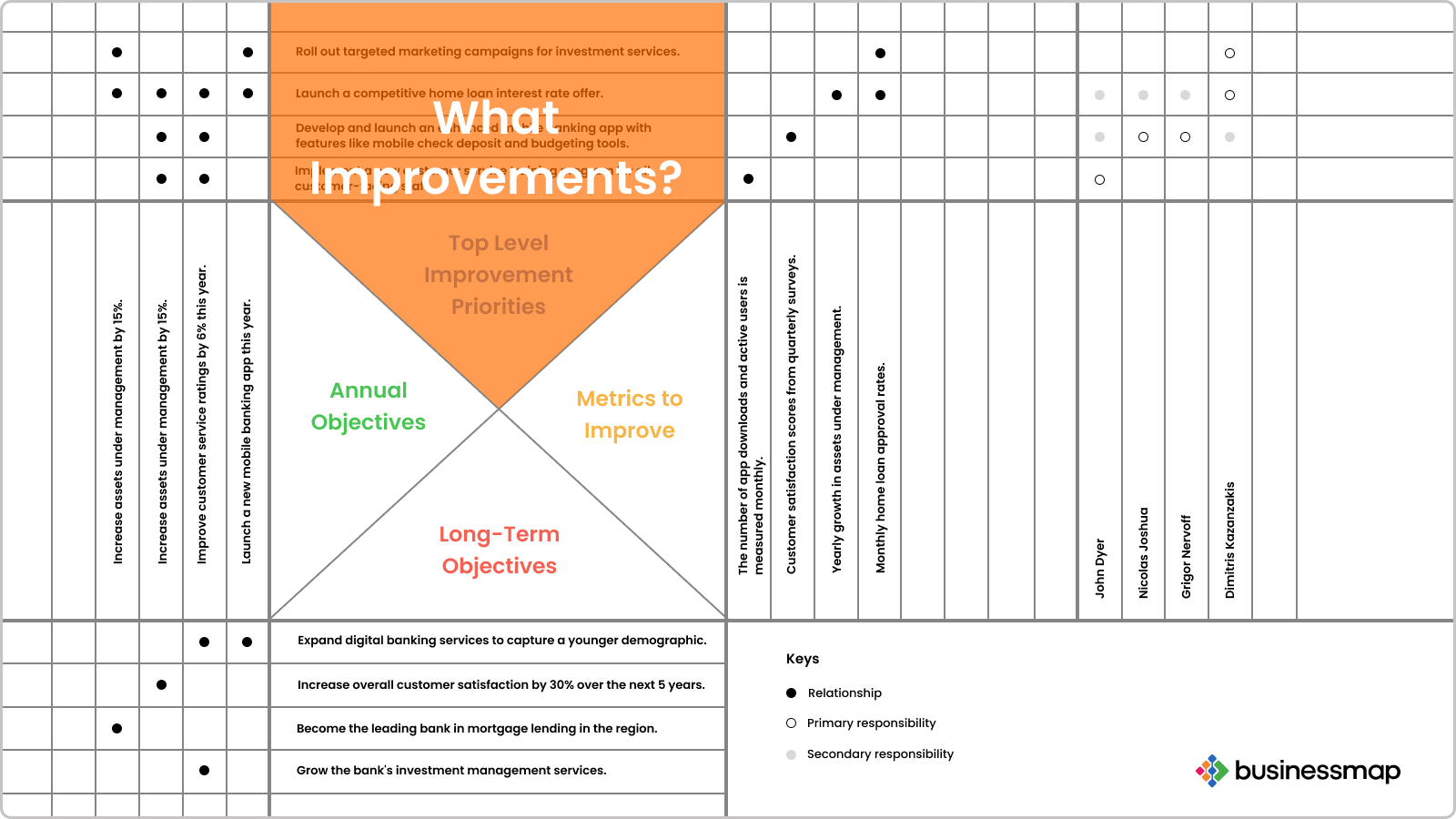 Mapping top priorities on a Hoshin Kanri X matrix
Mapping top priorities on a Hoshin Kanri X matrix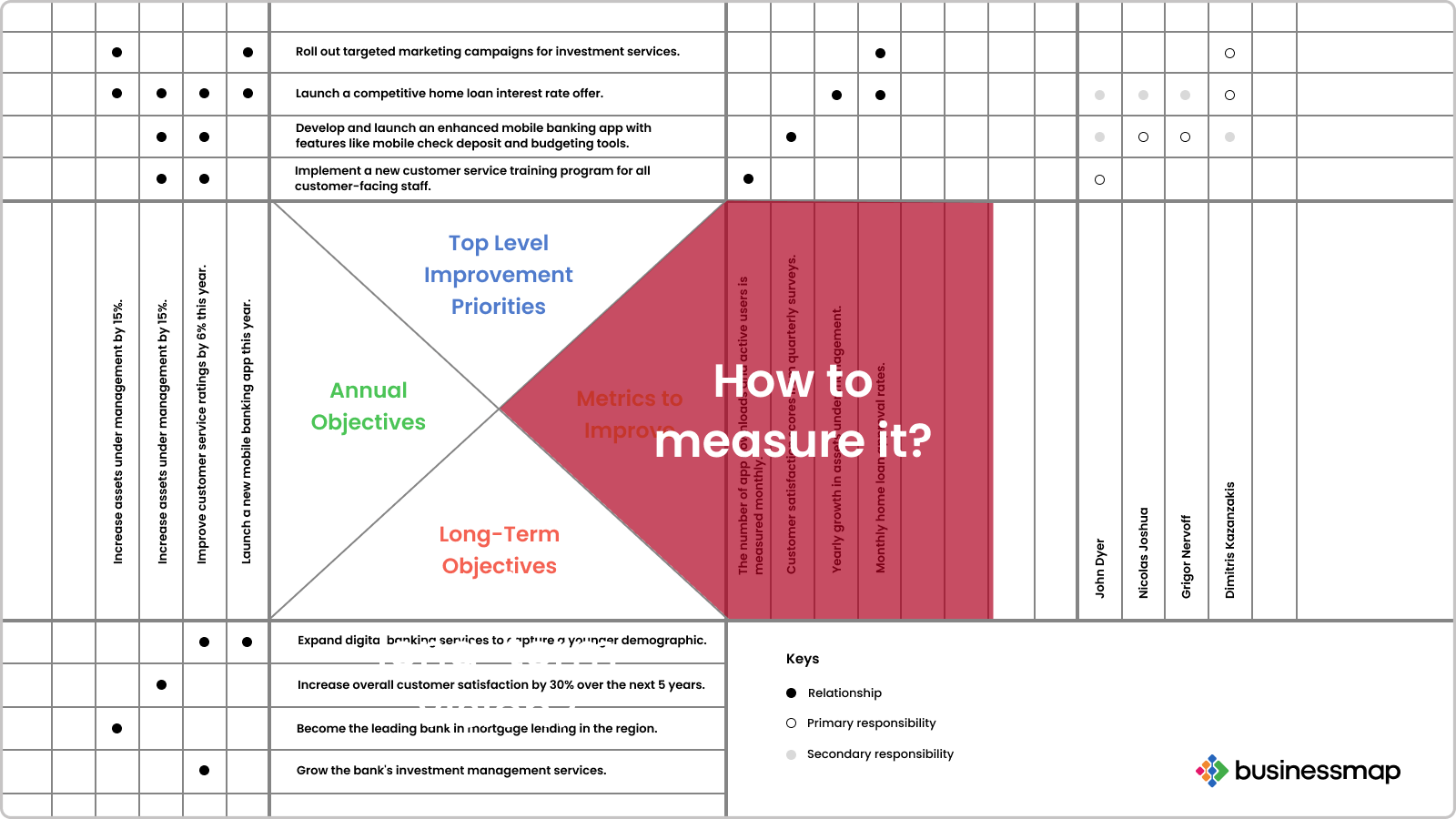 Visualizing key metrics on a Hoshin Kanri X matrix
Visualizing key metrics on a Hoshin Kanri X matrix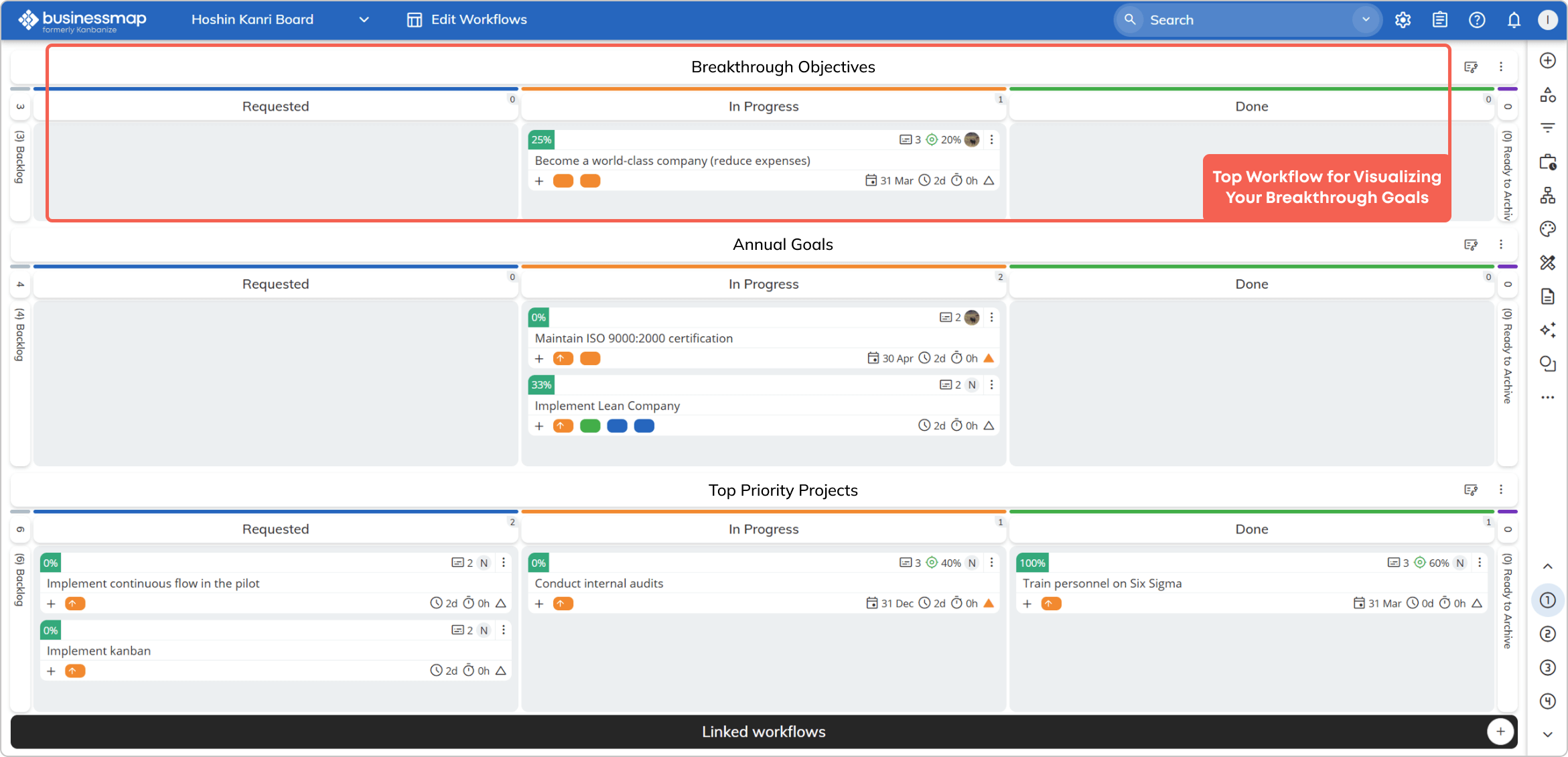 Using a Hoshin Kanri board to visualize breakthrough objectives in a top workflow in Businessmap
Using a Hoshin Kanri board to visualize breakthrough objectives in a top workflow in Businessmap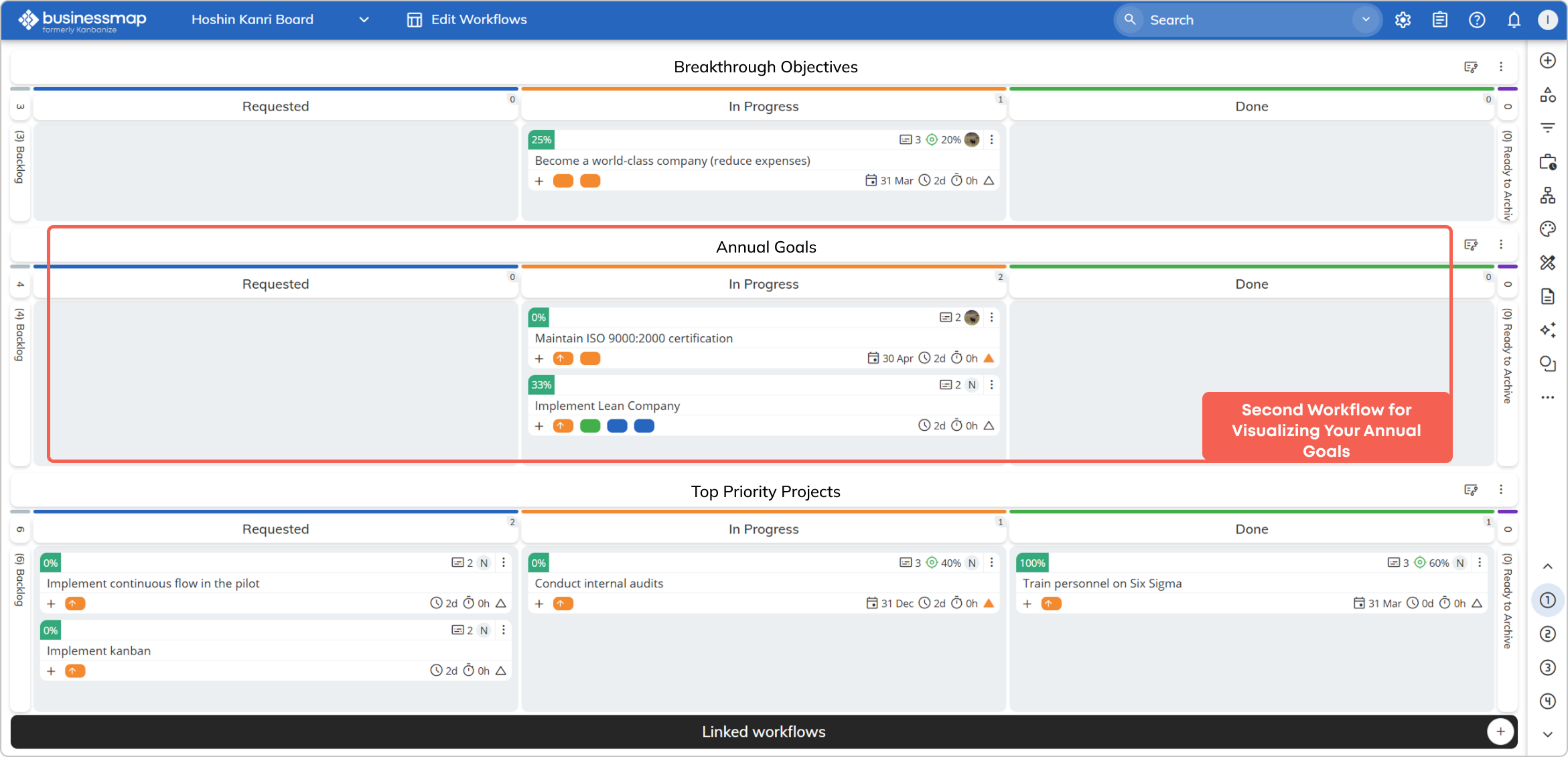 Visualizing annual goals in a second-layer workflow in Businessmap
Visualizing annual goals in a second-layer workflow in Businessmap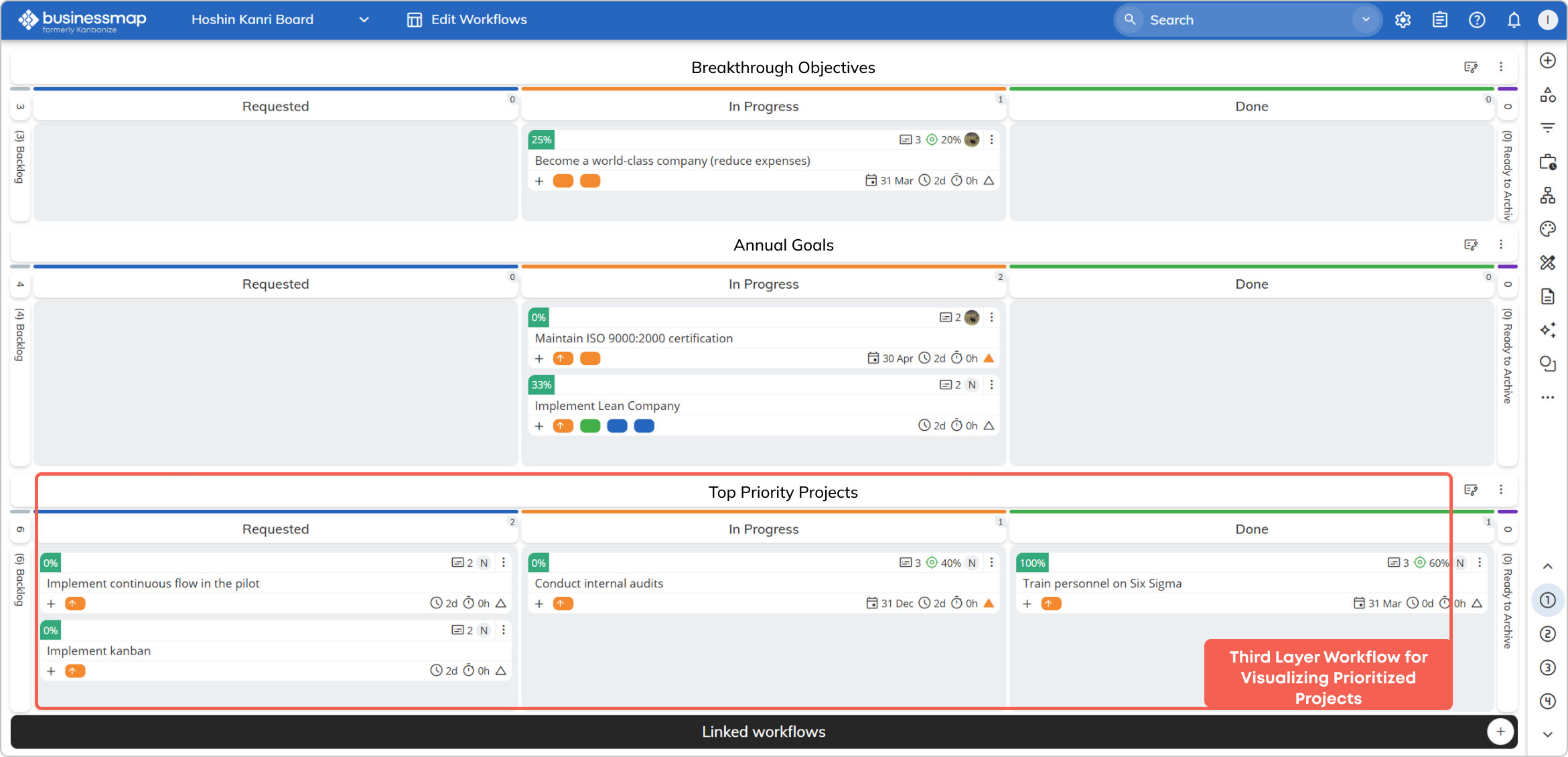 Visualizing top-priority projects on a Hoshin Kanri board in Businessmap
Visualizing top-priority projects on a Hoshin Kanri board in Businessmap

